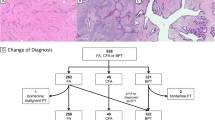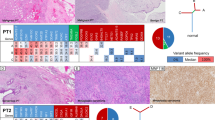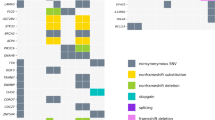Abstract
Breast fibroepithelial tumors comprise a heterogeneous spectrum of pathological entities, from benign fibroadenomas to malignant phyllodes tumors1. Although MED12 mutations have been frequently found in fibroadenomas and phyllodes tumors2,3,4,5,6,7, the landscapes of genetic alterations across the fibroepithelial tumor spectrum remain unclear. Here, by performing exome sequencing of 22 phyllodes tumors followed by targeted sequencing of 100 breast fibroepithelial tumors, we observed three distinct somatic mutation patterns. First, we frequently observed MED12 and RARA mutations in both fibroadenomas and phyllodes tumors, emphasizing the importance of these mutations in fibroepithelial tumorigenesis. Second, phyllodes tumors exhibited mutations in FLNA, SETD2 and KMT2D, suggesting a role in driving phyllodes tumor development. Third, borderline and malignant phyllodes tumors harbored additional mutations in cancer-associated genes. RARA mutations exhibited clustering in the portion of the gene encoding the ligand-binding domain, functionally suppressed RARA-mediated transcriptional activation and enhanced RARA interactions with transcriptional co-repressors. This study provides insights into the molecular pathogenesis of breast fibroepithelial tumors, with potential clinical implications.
This is a preview of subscription content, access via your institution
Access options
Subscribe to this journal
Receive 12 print issues and online access
$209.00 per year
only $17.42 per issue
Buy this article
- Purchase on Springer Link
- Instant access to full article PDF
Prices may be subject to local taxes which are calculated during checkout




Similar content being viewed by others
Accession codes
References
Lakhani, S., Ellis, I., Schnitt, S., Tan, P. & Van de Vijver, M. World Health Organisation Classification of Tumors of the Breast vol. 4, 142–147 (International Agency for Research on Cancer, 2012).
Lim, W.K. et al. Exome sequencing identifies highly recurrent MED12 somatic mutations in breast fibroadenoma. Nat. Genet. 46, 877–880 (2014).
Nagasawa, S. et al. MED12 exon 2 mutations in phyllodes tumors of the breast. Cancer Med. 4, 1117–1121 (2015).
Piscuoglio, S. et al. MED12 somatic mutations in fibroadenomas and phyllodes tumours of the breast. Histopathology 10.1111/his.12712 (8 April 2015).
Yoshida, M. et al. Frequent MED12 mutations in phyllodes tumours of the breast. Br. J. Cancer 112, 1703–1708 (2015).
Lien, H.C., Huang, C.S., Yang, Y.W. & Jeng, Y.M. Mutational analysis of MED12 exon 2 in a spectrum of fibroepithelial tumours of the breast: implications for pathogenesis and histogenesis. Histopathology 10.1111/his.12764 (25 June 2015).
Ng, C.C. et al. MED12 is frequently mutated in breast phyllodes tumours: a study of 112 cases. J. Clin. Pathol. 68, 685–691 (2015).
Tan, P.H. et al. Phyllodes tumors of the breast: the role of pathologic parameters. Am. J. Clin. Pathol. 123, 529–540 (2005).
Krishnamurthy, S., Ashfaq, R., Shin, H.J. & Sneige, N. Distinction of phyllodes tumor from fibroadenoma: a reappraisal of an old problem. Cancer 90, 342–349 (2000).
Hodges, K.B. et al. Evidence for transformation of fibroadenoma of the breast to malignant phyllodes tumor. Appl. Immunohistochem. Mol. Morphol. 17, 345–350 (2009).
Kuijper, A. et al. Analysis of the progression of fibroepithelial tumours of the breast by PCR-based clonality assay. J. Pathol. 197, 575–581 (2002).
Noguchi, S. et al. Progression of fibroadenoma to phyllodes tumor demonstrated by clonal analysis. Cancer 76, 1779–1785 (1995).
Kasami, M. et al. Monoclonality in fibroadenomas with complex histology and phyllodal features. Breast Cancer Res. Treat. 50, 185–191 (1998).
Abe, M. et al. Malignant transformation of breast fibroadenoma to malignant phyllodes tumor: long-term outcome of 36 malignant phyllodes tumors. Breast Cancer 18, 268–272 (2011).
Cani, A.K. et al. Next-gen sequencing exposes frequent MED12 mutations and actionable therapeutic targets in phyllodes tumors. Mol. Cancer Res. 13, 613–619 (2015).
Tan, W.J. et al. Novel genetic aberrations in breast phyllodes tumours: comparison between prognostically distinct groups. Breast Cancer Res. Treat. 145, 635–645 (2014).
Jones, A.M. et al. A comprehensive genetic profile of phyllodes tumours of the breast detects important mutations, intra-tumoral genetic heterogeneity and new genetic changes on recurrence. J. Pathol. 214, 533–544 (2008).
Cancer Genome Atlas Network Comprehensive molecular portraits of human breast tumours. Nature 490, 61–70 (2012).
Banerji, S. et al. Sequence analysis of mutations and translocations across breast cancer subtypes. Nature 486, 405–409 (2012).
Curtis, C. et al. The genomic and transcriptomic architecture of 2,000 breast tumours reveals novel subgroups. Nature 486, 346–352 (2012).
Stephens, P.J. et al. The landscape of cancer genes and mutational processes in breast cancer. Nature 486, 400–404 (2012).
Boeva, V. et al. Multi-factor data normalization enables the detection of copy number aberrations in amplicon sequencing data. Bioinformatics 30, 3443–3450 (2014).
Boeva, V. et al. Control-FREEC: a tool for assessing copy number and allelic content using next-generation sequencing data. Bioinformatics 28, 423–425 (2012).
Miller, C.A. et al. SciClone: inferring clonal architecture and tracking the spatial and temporal patterns of tumor evolution. PLoS Comput. Biol. 10, e1003665 (2014).
Mäkinen, N. et al. MED12, the mediator complex subunit 12 gene, is mutated at high frequency in uterine leiomyomas. Science 334, 252–255 (2011).
Barbieri, C.E. et al. Exome sequencing identifies recurrent SPOP, FOXA1 and MED12 mutations in prostate cancer. Nat. Genet. 44, 685–689 (2012).
Assié, G. et al. Integrated genomic characterization of adrenocortical carcinoma. Nat. Genet. 46, 607–612 (2014).
Zhu, H.H., Qin, Y.Z. & Huang, X.J. Resistance to arsenic therapy in acute promyelocytic leukemia. N. Engl. J. Med. 370, 1864–1866 (2014).
Kang, Y.K., Guermah, M., Yuan, C.X. & Roeder, R.G. The TRAP/Mediator coactivator complex interacts directly with estrogen receptors α and β through the TRAP220 subunit and directly enhances estrogen receptor function in vitro. Proc. Natl. Acad. Sci. USA 99, 2642–2647 (2002).
Ross-Innes, C.S. et al. Cooperative interaction between retinoic acid receptor-α and estrogen receptor in breast cancer. Genes Dev. 24, 171–182 (2010).
Savoy, R.M. & Ghosh, P.M. The dual role of filamin A in cancer: can't live with (too much of) it, can't live without it. Endocr. Relat. Cancer 20, R341–R356 (2013).
Nakamura, F., Osborn, T.M., Hartemink, C.A., Hartwig, J.H. & Stossel, T.P. Structural basis of filamin A functions. J. Cell Biol. 179, 1011–1025 (2007).
Zhu, X. et al. Identification of functional cooperative mutations of SETD2 in human acute leukemia. Nat. Genet. 46, 287–293 (2014).
Pasqualucci, L. et al. Analysis of the coding genome of diffuse large B-cell lymphoma. Nat. Genet. 43, 830–837 (2011).
Cimino-Mathews, A. et al. A subset of malignant phyllodes tumors harbors alterations in the Rb/p16 pathway. Hum. Pathol. 44, 2494–2500 (2013).
Feakins, R.M., Mulcahy, H.E., Nickols, C.D. & Wells, C.A. p53 expression in phyllodes tumours is associated with histological features of malignancy but does not predict outcome. Histopathology 35, 162–169 (1999).
Millar, E.K. et al. Malignant phyllodes tumours of the breast display increased stromal p53 protein expression. Histopathology 34, 491–496 (1999).
Sawyer, E.J. et al. Molecular analysis of phyllodes tumors reveals distinct changes in the epithelial and stromal components. Am. J. Pathol. 156, 1093–1098 (2000).
Jara-Lazaro, A.R. & Tan, P.H. Molecular pathogenesis of progression and recurrence in breast phyllodes tumors. Am. J. Transl. Res. 1, 23–34 (2009).
Cerami, E. et al. The cBio cancer genomics portal: an open platform for exploring multidimensional cancer genomics data. Cancer Discov. 2, 401–404 (2012).
Altucci, L. & Gronemeyer, H. The promise of retinoids to fight against cancer. Nat. Rev. Cancer 1, 181–193 (2001).
Markowski, D.N. et al. MED12 mutations in uterine fibroids—their relationship to cytogenetic subgroups. Int. J. Cancer 131, 1528–1536 (2012).
Chan-On, W. et al. Exome sequencing identifies distinct mutational patterns in liver fluke–related and non-infection–related bile duct cancers. Nat. Genet. 45, 1474–1478 (2013).
Thorvaldsdóttir, H., Robinson, J.T. & Mesirov, J.P. Integrative Genomics Viewer (IGV): high-performance genomics data visualization and exploration. Brief. Bioinform. 14, 178–192 (2013).
Saunders, C.T. et al. Strelka: accurate somatic small-variant calling from sequenced tumor-normal sample pairs. Bioinformatics 28, 1811–1817 (2012).
Sherry, S.T. et al. dbSNP: the NCBI database of genetic variation. Nucleic Acids Res. 29, 308–311 (2001).
Ng, P.C. & Henikoff, S. SIFT: predicting amino acid changes that affect protein function. Nucleic Acids Res. 31, 3812–3814 (2003).
Reva, B., Antipin, Y. & Sander, C. Predicting the functional impact of protein mutations: application to cancer genomics. Nucleic Acids Res. 39, e118 (2011).
Choi, Y. & Chan, A.P. PROVEAN web server: a tool to predict the functional effect of amino acid substitutions and indels. Bioinformatics 31, 2745–2747 (2015).
Carter, H. et al. Cancer-specific high-throughput annotation of somatic mutations: computational prediction of driver missense mutations. Cancer Res. 69, 6660–6667 (2009).
Acknowledgements
This work was supported in part by funding from the Singapore National Medical Research Council (NMRC/STAR/0006/2009), the Singapore National Cancer Centre Research Fund, the Lee Foundation, the Tanoto Foundation and the Verdant Foundation. We thank the Duke–National University of Singapore Genome Biology Facility for sequencing services rendered, as well as the Advanced Molecular Pathology Laboratory, Institute of Molecular and Cell Biology (IMCB), Agency for Science, Technology and Research (A*STAR), Singapore, for providing laser-capture microdissection resources and the SingHealth Tissue Repository for frozen tissue samples.
Author information
Authors and Affiliations
Contributions
J.T., C.K.O., W.K.L., S.G.R., P.T., P.H.T. and B.T.T. conceived the study. S.G.R., P.T., P.H.T. and B.T.T. directed the study and supervised the research. J.R.M., W.K.L., I.C., S.N., J.Q.L., S.T., S.D., L.M.N. and G.P. performed the bioinformatics analysis. A.A.T., N.D.M.N., T.C.P., B.S.A., P.I., C.W.C., A.P.H.T., W.S.Y., P.M., G.H.H., V.K.M.T., C.Y.W., M.H., K.W.O. and B.K.T.T. collected tumor specimens, confirmed histopathology findings and interpreted the clinical data. S.S.M. was involved in sample preparation. C.C.Y.N., V.R., Z.L., G.C.W., D.H., B.H.W. and S.T.T. performed whole-exome sequencing, Sanger sequencing and targeted sequencing. J.T., C.K.O., W.K.L., S.G.R., P.T., P.H.T. and B.T.T. wrote the manuscript, with the assistance and final approval of all authors.
Corresponding authors
Ethics declarations
Competing interests
The authors declare no competing financial interests.
Supplementary information
Supplementary Text and Figures
Supplementary Figures 1–10, Supplementary Tables 1, 2, 4, 6–8 and 10. (PDF 3810 kb)
Supplementary Table 3
List of candidate somatic mutations identified from whole-exome sequencing of 22 cases of phyllodes tumor. (XLSX 54 kb)
Supplementary Table 5
Somatic mutations detected by targeted sequencing in 100 fibroepithelial tumors. (XLSX 41 kb)
Supplementary Table 9
List of synonymous mutations identified from whole-exome sequencing of 22 cases of phyllodes tumors. (XLSX 19 kb)
Supplementary Data Set 1
Clonality analysis data. (ZIP 1005 kb)
Supplementary Data Set 2
Images of copy number variants in 100 fibroepithelial tumors. (ZIP 10622 kb)
Supplementary Data Set 3
Genome browser snapshots for candidate variants in targeted sequencing data. (ZIP 4564 kb)
Rights and permissions
About this article
Cite this article
Tan, J., Ong, C., Lim, W. et al. Genomic landscapes of breast fibroepithelial tumors. Nat Genet 47, 1341–1345 (2015). https://doi.org/10.1038/ng.3409
Received:
Accepted:
Published:
Issue Date:
DOI: https://doi.org/10.1038/ng.3409
This article is cited by
-
Spindle cell lesions of the breast: a diagnostic approach
Virchows Archiv (2022)
-
Therapeutic and immunomodulatory potential of pazopanib in malignant phyllodes tumor
npj Breast Cancer (2022)
-
Droplet-digital PCR reveals frequent mutations in TERT promoter region in breast fibroadenomas and phyllodes tumours, irrespective of the presence of MED12 mutations
British Journal of Cancer (2021)
-
Clinicopathologic and genetic features of metaplastic breast cancer with osseous differentiation: a series of 6 cases
Breast Cancer (2021)
-
Histopathologic, immunophenotypic, and proteomics characteristics of low-grade phyllodes tumor and fibroadenoma: more similarities than differences
npj Breast Cancer (2020)



